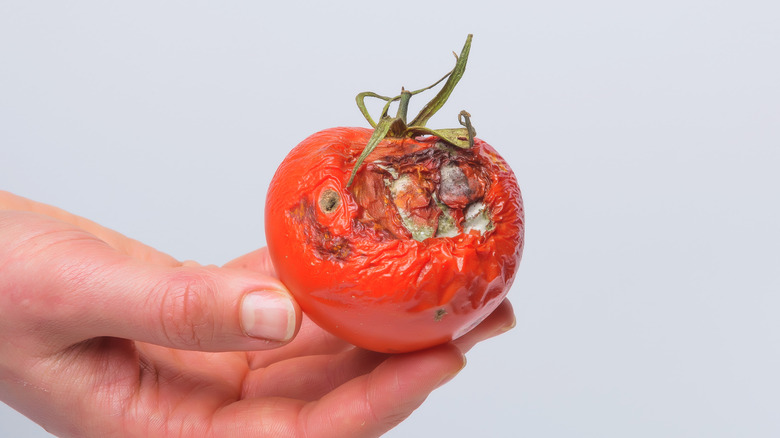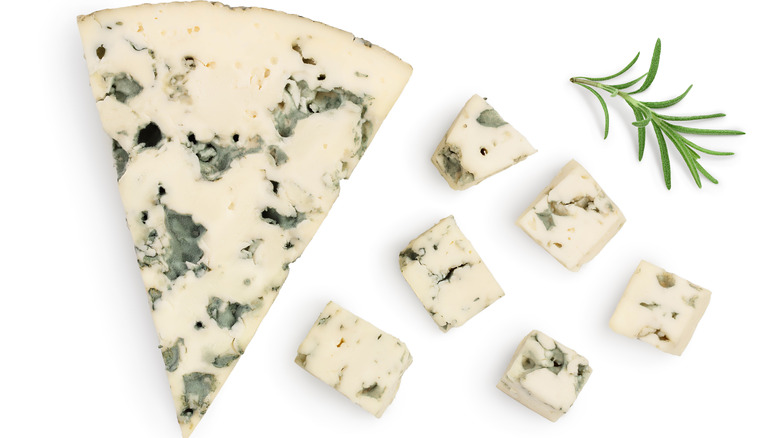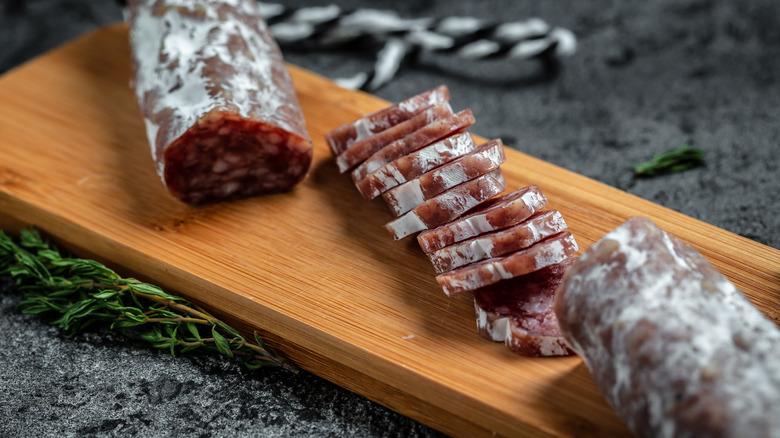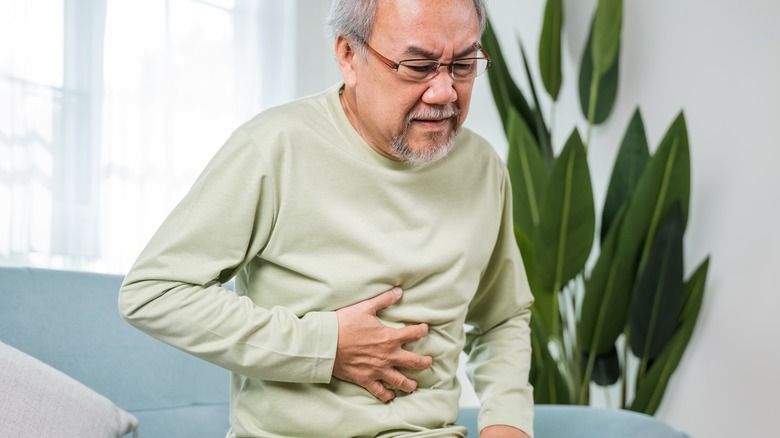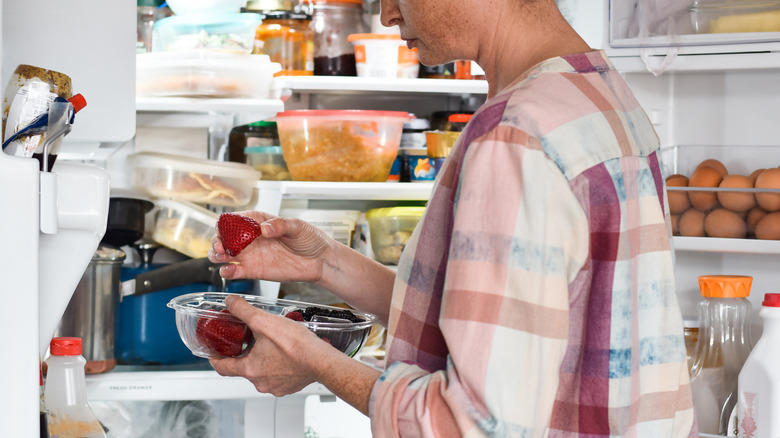When You Accidentally Eat Mold, This Is What Happens
Mold is gross, no doubt about it. Opening a container of strawberries or a loaf of bread and seeing the familiar bluish-gray fuzz is totally cringe-worthy. But what if you don't spot the mold until after you've eaten half your sandwich or a few strawberries? Are you destined to get sick?
Mold is a microscopic fungi that is practically ubiquitous in our environments, since it's found indoors and outdoors, and can grow wherever there are high levels of moisture, low light, and above-freezing temperatures — think basements, bathrooms, and refrigerators.
According to The Mold Source, there are over 100,000 types of mold. Thankfully, most of them are harmless to healthy individuals with strong immune systems. Marina Yuabova, D.N.P., a doctor of nursing practice and nurse practitioner in New York City, told Shape, "When the immune system works well, and healthy gut flora is abundant, molds will have no negative impact on the health and wellness of that individual." In other words, most of the time, if you accidentally eat a bit of something moldy, you should just forget about it and move on. As Rudolph Bedford, M.D., a gastroenterologist at Providence Saint John's Health Center in Santa Monica told Women's Health Magazine, "You're not going to die from eating mold."
Some types of mold are actually good for you
For some people though, exposure to mold — whether eaten or otherwise — can cause an allergic reaction or respiratory illness. And while most molds are ultimately harmless, a few, under the right conditions, produce poisonous substances called mycotoxins, which can make you really sick.
But what about moldy blue cheese? And what if you really don't want to chuck that smoked gouda because of the moldy corner section? Well, here's some good news: blue-veined cheeses are actually made with Penicillium mold spores, and are perfectly safe (and even healthy) to eat (via Food & Wine).
When it comes to the food in our kitchens, the US Department of Agriculture (USDA) has put out some handy guidelines on how to handle mold. For hard cheeses and firm fruits and vegetables (like carrots), cut off at least one inch around and below the moldy area, being careful to keep the knife away from the mold so as not to contaminate the rest of the food.
For soft fruits and vegetables, foods with a high moisture content (like yogurt and jams), and breads, it's safest to just toss the whole thing. That's because mold has 'roots' that can spread deep into soft foods, well below the visibly-moldy surface. Not only that, but bacteria can grow there along with the mold.
Even though a couple of bites of mold most likely won't make you sick, it's smart to err on the side of caution. "When in doubt, throw it out" isn't just a catch-phrase for recyclers — it's great advice in the kitchen too.
Which molds make you sick and which are okay?
So which kinds of molds are safe to eat, and which can potentially make us ill if we were to accidentally swallow them? According to the U.S. Department of Agriculture (USDA), molds used in the manufacturing of food items are generally safe for healthy adults to consume.
Experts at PharmEasy state that Aspergillus, Penicillium, Fusarium, Mucor, and Rhizopus are the kinds of molds you'll most often find in your kitchen. Meat and poultry can become contaminated by all of these molds and more. In the event that any variety of mold is spotted on high-moisture meats, such as bacon, hot dogs, or leftover chicken, it belongs in the trash. However, there are some exceptions to the moldy meat rule. You can also find species of Penicillium on certain types of hard salami, but that dusting of white on the meat's outer casing is A-OK to eat. On the other hand, while it's not uncommon to spot mold on dry-cured country hams, it should always be removed before eating by thoroughly washing the meat with hot water and applying a little elbow grease using a stiff vegetable brush (via USDA). While the molds on dry-cured country hams are not always dangerous, you don't want to take any chances when it comes to mycotoxins.
More information on the health risks of mycotoxins
Molds you want to steer clear of include the green or black fungi you'd find on a long-forgotten loaf of bread, any green-gray specks that develop on the outside of fruits, or the white, fuzzy patches that can overtake berries, experts tell Today. All of these food items should be promptly discarded, along with any foods that develop orange, red, or pink mold. The presence of these molds signals that food has gone bad, and although a small nibble isn't guaranteed to make a healthy person sick, there's no way to know whether these molds may harbor mycotoxins.
High temperatures, humid environments, and pH levels are just a few of the different factors that can create the perfect storm for mold to give off poisonous mycotoxins (via AIMS Agriculture and Food). Mycotoxin-producing molds are often found in nut crops, grain, apples, celery, grape juice, and more (via USDA). Able to make us sick if ingested in large quantities (or in small quantities for people with mold allergies), a 2018 scientific article published in Toxicological Research outlines how mycotoxin consumption can cause vomiting, diarrhea, headaches, gastrointestinal distress, and more. Millions of people die every year from these poisonous substances.
Aflatoxins may cause cancer and other health problems
While there are different kinds of mycotoxins, aflatoxins pose the greatest risks to human health (via USDA). Even when eaten in small amounts, these highly poisonous substances produced by certain molds have been linked to cancer, DNA mutation, liver cell damage, and more. Cases of aflatoxicosis, pregnancy loss, developmental issues in children, malnutrition, and more have been seen in connection with aflatoxin exposure, according to the 2024 edition of the "Encyclopedia of Toxicology" (via ScienceDirect). These toxins are primarily produced by strains of Aspergillus fungi. Although aflatoxins have been the subject of study around the world for decades, they present unique challenges when it comes to preventing their contamination of crops.
We've covered hard cheeses, firm fruits and veggies, and dry-cured country hams in terms of how to safely cut off any moldy sections of these foods, but we don't want to mess around with potential mycotoxins and aflatoxins. Jellies and jams tend to be particularly vulnerable to these harmful molds. If these sandwich spreads become moldy, get rid of them. You don't want to spoon out the contaminated surface and hang onto the product, as there could be more fungi invisibly lurking underneath. Visit the USDA's Food Safety and Inspection Service website for more information on how to best protect yourself from mold exposure through food.

